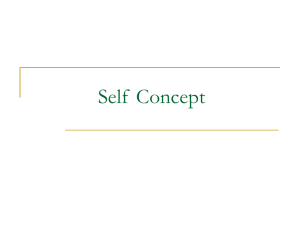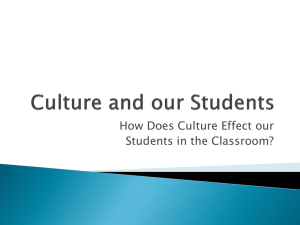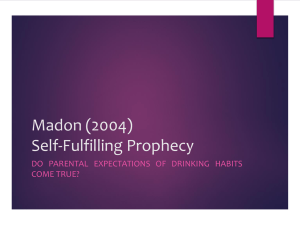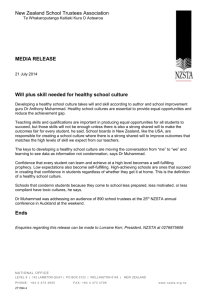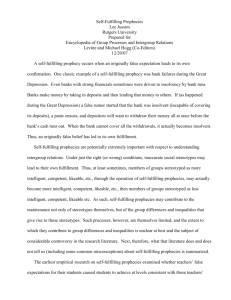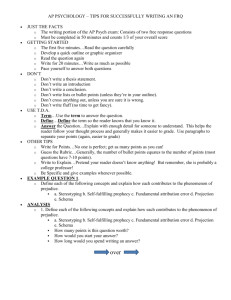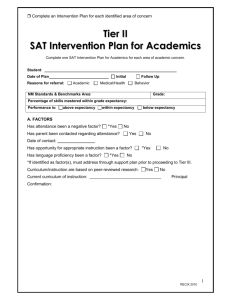Teacher expectations. - Program for Disability Research
advertisement
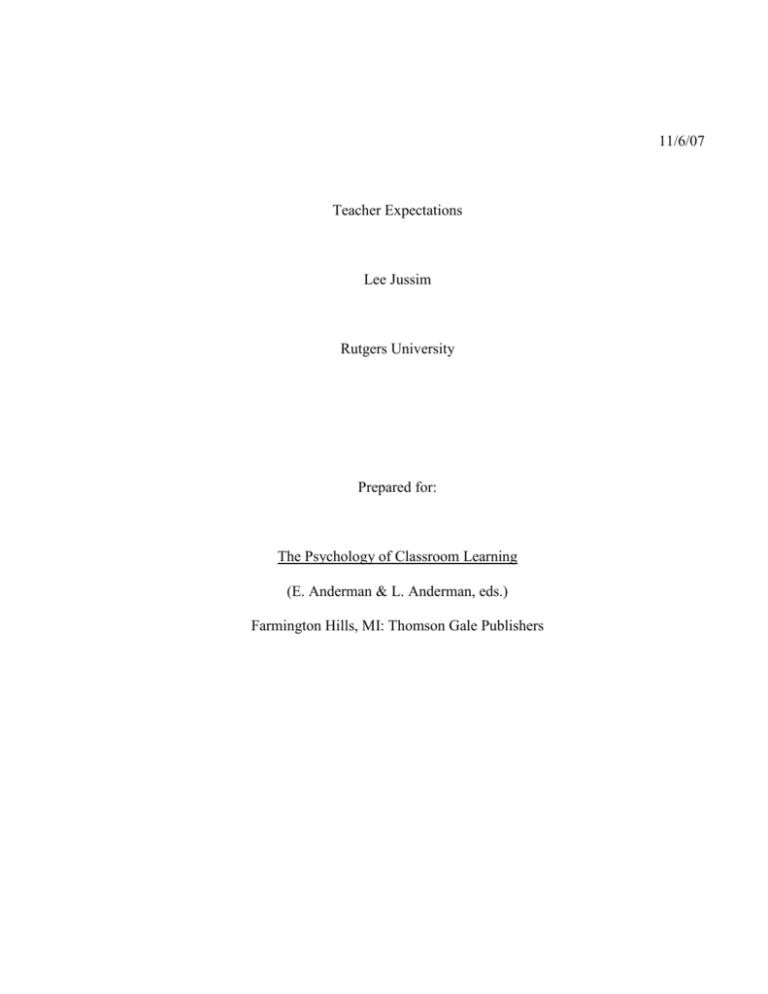
11/6/07 Teacher Expectations Lee Jussim Rutgers University Prepared for: The Psychology of Classroom Learning (E. Anderman & L. Anderman, eds.) Farmington Hills, MI: Thomson Gale Publishers -2How are teacher expectations related to student achievement? For decades, now, social psychologists have emphasized the power of expectations to create and distort social reality through self-fulfilling prophecies and expectancy-confirming biases, whereas educational psychologists typically emphasize the accuracy of teacher expectations. This short entry conveys why 40 years of research on teacher expectations shows that teacher expectations are indeed mostly accurate, and that they lead to typically small but occasionally large self-fulfilling prophecies. Definitions: Teacher Expectations and Related Constructs In studies on “teacher expectations” the term has referred to everything from predictions to beliefs about current levels of ability and performance, to beliefs about students’ “normative” behavior (essentially, cooperativeness, rule-following, etc.). The term “expectancy effect” refers to either of two related yet very different phenomena. Both, however, start with an erroneous expectation. Bias. First, erroneous expectations may bias the expectancy-holder’s judgments, a phenomenon sometimes referred to as “expectancy-confirming bias,” “perceptual bias,” or “confirmatory bias.” Sometimes, perceivers’ (including teachers’) erroneous expectations lead them to judge, evaluate, interpret or explain targets’ (including students’) behavior in ways consistent with those expectations. For example, if a teacher overestimates a student’s academic competence, that teacher may evaluate the student’s performance (on tests, homeworks, etc.) more positively than the same teacher evaluates identical work produced by a student whose academic competence the teacher underestimates. These types of expectancy biases influence the teacher’s judgments about students’ learning or achievement, but they do not influence students’ actual learning or achievement. Self-fulfilling prophecy. A self-fulfilling prophecy occurs when a perceiver’s originally false expectation leads to its own actual (not merely perceived) confirmation. An erroneous teacher’s expectation leads to its own fulfillment when it leads the teacher to behave different towards high and low expectancy students, and when those students’ achievement changes to confirm the teacher’s -3(originally false, but now true) expectation. Thus, the high expectancy student achieves at higher levels, and the low expectancy student achieves at lower levels (or learns less). Expectancy-confirming biases and self-fulfilling prophecies are similar because both involve expectations causing their own confirmation in some sense (which is why both are termed “expectancy effects”). They differ, however, in that the confirmation in expectancy-confirming biases occurs entirely in the mind of the perceiver (or teacher), whereas the confirmation in selffulfilling prophecy occurs as a result of an actual change in the behavior (or achievement) of the target (or student). Accuracy. Teacher accuracy refers to correspondence between teachers’ beliefs (expectations, perceptions, judgments, etc.) about one or more students and those students characteristics or accomplishments, if the teachers’ beliefs have not caused those characteristics or accomplishments (if so, then this would be self-fulfilling prophecy). Accuracy is important for two reasons. First, accuracy constitutes a very different explanation (than bias or self-fulfilling prophecy) for why students may sometimes confirm teachers’ expectations. When “expectancy confirmation” results from accuracy, it reflects teachers’ expertise and competence, rather than their flaws and weaknesses. Second, accuracy is extremely important with respect to understanding research on teacher expectations, because it represents a potential plausible alternative explanation (to self-fulfilling prophecy or bias) for evidence that students confirm teachers’ expectations. The Pygmalion Study The scientific study of teacher expectations was launched by the classic and controversial Pygmalion study (Rosenthal & Jacobson, 1968). Rosenthal & Jacobson led teachers to believe that some students in their classes were "late bloomers" -- destined to show dramatic increases in IQ over the school year. In fact, these students had been selected at random. Results showed that, especially in the earlier grade levels, the "late bloomers" gained more in IQ than other students. Teacher expectations created a self-fulfilling prophecy. -4Rosenthal & Jacobson's study (1968) received considerable attention in some social science circles and in the popular press because it seemed to provide a powerful explanation for the low achievement of "disadvantaged" students. However, it was also criticized by educational psychologists on conceptual, methodological, and statistical grounds. A controversy over the existence of the phenomenon continued over the next ten years, which included numerous attempts to replicate in classrooms and other contexts (work settings, job training programs, laboratories, etc.). Consistently, only about one third of the studies attempting to demonstrate a self-fulfilling prophecy succeeded (Rosenthal & Rubin, 1978). This pattern was often interpreted by critics as demonstrating that the phenomenon did not exist because support was unreliable. It was interpreted by proponents as demonstrating the existence of self-fulfilling prophecies because, if only chance differences were occurring, replications would only succeed about 5% of the time. Rosenthal & Rubin's (1978) meta-analysis of the first 345 studies of interpersonal expectancy effects conclusively demonstrated the existence of self-fulfilling prophecies. The overall expectancy effect size was equal to a correlation of about .30 between teacher expectations and student achievement, and the probability of finding the observed expectancy effects, if the phenomenon did not exist, was essentially zero. Remaining Controversy: Teacher Expectations and Student Intelligence The most stunning claim that emerged from Rosenthal and Jacobson's (1968) study was that teacher expectations have self-fulfilling effects on intelligence. Although IQ test scores often are the best predictors of many important life outcomes, they are also notoriously resistant to change in response to social interventions designed to increase them. In this context, the claim that teacher expectations influence IQ was extremely important, controversial, and difficult (for some) to believe. Unfortunately, the original Pygmalion study included some results that some researchers found difficult to believe. For example, there were five "bloomers" with wild IQ score gains: 17-110, -518-122, 133-202, 111-208, and 113-211. If one simply excluded these five bizarre gains, the difference between the bloomers and the controls evaporated. Thus, the claim that the Pygmalion showed that teacher expectations can have self-fulfilling effects on student intelligence was not universally accepted. Unfortunately, the subsequent evidence has also been unclear on this issue, with some reviews concluding that the effect of teacher expectations on student intelligence averages near zero, and others concluding that such effects are small, but above zero. The fairest conclusion that can be reached, therefore, is that, if teacher expectations do have an effect on student intelligence, it is typically quite small. Naturally-Occurring Versus Experimentally-Induced Teacher Expectations A limitation of the original Pygmalion study and many follow up experiments was that researchers intentionally misled teachers into believing that some students were likely to show dramatic achievement gains. In general, however, teachers do not develop expectations based on falsified information. Thus, some researchers examined whether self-fulfilling prophecies also occurred when teachers developed their expectations naturally, without intervention by experiments. Identifying causal effects of teacher expectations was much more difficult in nonexperimental research than in experimental research. In nonexperimental research any particular correlation between teacher expectations and student achievement might occur because teacher expectations caused student achievement (self-fulfilling prophecy), student achievement caused teacher expectations, or some third variable or variables caused them both. To address this issue, most naturalistic studies did two things. First, they used a longitudinal (over time) design, which take advantage of the fact that the future cannot possibly cause the past. This rules out one possible causal direction. If teacher expectations are measured early in the year, and student achievement late in the year, that student achievement cannot cause those teacher expectations. Second, naturalistic studies also typically statistically controlled for many of the most plausible predictors of teacher expectations and student future achievement, including student past -6achievement and demographics, and, sometimes, student self-concept and motivation. If teacher expectations early in the year predict student achievement late in the year, after controlling for all these variables, many “third variable” explanations can be eliminated. Interestingly, the naturalistic research consistently did find evidence consistent with a selffulfilling prophecy. In most studies, teacher expectations early in the year did indeed predict student achievement late in the year, even after controlling for student prior achievement, demographics, motivation, and self-concept. In fact, the self-fulfilling prophecy effect sizes in such studies was typically about .1 to .2 (in terms of standardized regression coefficients relating teacher expectations to student achievement). Although statistically significantly, these effects were consistently lower than found in Rosenthal & Rubin’s (1978) meta-analysis of the experiments. Why might this be? The most likely explanation was that under naturally-occurring conditions, teachers’ expectations may often be accurate. Indeed, nearly all naturalistic studies of teacher expectations find that: 1) student past achievement has large effects on teachers’ expectations; 2) teacher expectations predict (correlate with) student future achievement much more highly than they cause student achievement. These findings are extremely important because they reflect two types of accuracy. The first shows that teacher impression accuracy is high (impression accuracy is the extent to which teachers’ expectations correspond with students’ current characteristics or achievement). The second shows that teacher predictive accuracy is high (predictive accuracy is the extent to which teacher expectations predict but do not cause student achievement). Overall, the naturalistic research has shown that about 2/3 to ¾ of the reason teacher expectations predict student achievement is because those expectations are accurate, and that ¼ to 1/3 of the reason they predict student achievement is because of self-fulfilling prophecies. The naturalistic research has also consistently found that teacher expectations predict student grades more strongly than they predict standardized test scores (even after controlling for prior grades, achievement, and demographics). Because teachers assign grades but not standardized test -7scores, this result most likely reflects expectancy-confirmation bias – teacher expectations biasing their evaluations of students, rather than influencing students’ objective achievement. Both bias and self-fulfilling prophecy can and often do occur for grades, so that their effects are cumulative. Thus, “expectancy effects” for grades (combining both) often account for about half of the reason teacher expectations early in the year predict student grades (the remaining half being accuracy). Processes Bases of teacher expectations. Teacher expectations are primarily based on student prior achievement and grades, which helps account for their relatively high levels of predictive accuracy. Because of the obvious social implications, both experimental and nonexperimental research has been concerned with whether teacher expectations are also based on social stereotypes. Again, the results partially diverge. In experimental studies, the most common methodology has been to provide teachers with little or with ambiguous information about students from different groups (e.g., boys/girls, Africa-Americans/Whites, etc.), and to assess whether teachers hold higher expectations for students from one group. They often do. Because in real life, however, groups often do differ in average levels of achievement, such results do not necessarily show that stereotypes cause inaccuracy in teacher expectations. This issue, however, has also been addressed in naturalistic research, which has examined the extent to which student demographics predict teacher expectations, even after controlling for students’ actual differences in achievement. Such research most often finds little or no effect of student demographic characteristics, meaning that, when teachers do perceive demographic differences there usually are corresponding bona fide demographic differences. The most notable exception seems to involve student sex and teacher perceptions of effort. Teachers routinely assume that girls try harder at school than do boys, even though there is little evidence that they actually do. Because there is good evidence that, in general, girls are more cooperative and obedient than boys, it seems likely that this -8reflects a halo effect (the presence of one positive trait in a target leads the perceiver to infer all sorts of other positive attributes). In contrast to stereotypes, diagnostic labels (ADHD, learning disabled, neurologically impaired, etc.), presumably because they come with greater scientific credibility, are often powerful sources of teacher expectations. Unfortunately, however, large minorities of students are often mislabeled, and, even when students are appropriately diagnosed, many teachers lack the training to understand how best to maximize such students’ learning and achievement. Thus, diagnostic labels are often a culprit in negative self-fulfilling prophecies. Interpersonal processes. Much research has addressed how teachers act on their expectations in such a manner as to produce a self-fulfilling prophecy. This research has shown that teachers hold high expectancy students to higher standards of performance and, at the same time, provide a warmer and more supportive environment to them. Differential treatment can lead to self-fulfilling prophecies through either or both of two general routes. High standards means providing high expectancy students with more opportunities to master difficult material. When coupled with the support for doing so, highs may simply learn more material more quickly. In addition, however, differential treatment also may indirectly affect achievement, by enhancing or undermining student motivation. High standards and emotional support are likely to increase students’ psychological investment in school, intrinsic motivation, and self-expectations, all of which have well-established beneficial effects on achievement (and, of course, low standards and a cold emotional environment is likely to be demotivating). Moderating conditions. Another area of follow-up research examined moderators of selffulfilling prophecies – the conditions under which self-fulfilling prophecies are stronger or weaker. This research has shown that self-fulfilling prophecies are stronger: 1. When experimental studies manipulate them early rather than late in the year. It is much harder to mislead teachers later in the year, after they have gotten to know their students. -92. In first, second, and seventh grades, a result that suggests that it is not younger children per se who are more vulnerable, but children who enter new and unfamiliar situations (7th grade was the first grade of junior high school in many of the studies). 3. Among teachers high in dogmatism or cognitive rigidity. Even inaccurate expectations will not lead to self-fulfilling prophecies if teachers readily correct their expectations with new information. Teachers high in dogmatism or cognitive rigidity, however, are unlikely to do so. 4. Among students with some sort of stigma. Some of the largest self-fulfilling prophecy effects ever obtained have been found to occur among African-American students, those from lower social class backgrounds, and those with histories of low achievement. Many early researchers speculated that negative expectancy effects (those that undermine student achievement) were also more powerful than positive ones (those that enhance student achievement). Such speculations seem to have been largely misplaced, and the best evidence is that positive teacher expectations are more likely to enhance student achievement than negative ones are to harm student achievement. Implications For Teachers First, Teachers should take considerable comfort from the empirical evidence which, in contrast to some of the more extreme claims, shows that, in general, expectancy effects are small, fragile and fleeting, rather than large, pervasive, and enduring. Second, any recommendation suggesting that teachers should simply adopt high expectations for all students would be oversimplified, unworkable, and probably dysfunctional. High expectations can work at raising student achievement, but only if they are backed up with the resources and institutional supports to do so. The most constructive lessons to be learned for teachers from the research are the following: 1. Hold expectations flexibly. You might be wrong. The student’s label might be wrong. Also, students change. - 10 2. Holding high standards without providing a warm environment is merely harsh. A warm environment without high standards is simply feel-good mush. But if you can create a combination of high standards with a warm and supportive environment it will benefit all students, not just the high achievers. 3. High expectations will mean different things for different students. Attaining average performance might be high for one student and low for another. If one wants to purposely harness expectancy effects to maximize student achievement, one needs to couple a high expectation (for that student) with a clear plan for how that student will maximize their learning and achievement. Bibliography for Further Research Brophy, J. (1983). Research on the self-fulfilling prophecy and teacher expectations. Journal of Educational Psychology, 75, 631-661. Brophy, J., & Good, T. (1974). Teacher-student relationships: Causes and consequences. New York: Holt, Rinehart, and Winston. Harris, M. J., & Rosenthal, R. (1985). Mediation of interpersonal expectancy effects: 31 meta-analyses. Psychological Bulletin, 97, 363-386. Jussim, L. (1986). Self-fulfilling prophecies: A theoretical and integrative review. Psychological Review, 93, 429-445. Jussim, L. (1991). Social perception and social reality: A reflection-construction model. Psychological Review, 98, 54-73. Jussim, L., Smith, A., Madon, S., & Palumbo, P. (1998). Teacher expectations. In J. Brophy (ed.), Advances in research on teaching, Vol. 7, (pp. 1-48). Greenwich, CT: JAI Press. Jussim, L., & Harber, K. (2005). Teacher expectations and self-fulfilling prophecies: Knowns and unknowns; resolved and unresolved controversies. Personality and Social Psychology Review. Rosenthal, R., & Jacobson, L. (1968). Pygmalion in the classroom: Teacher expectations and student intellectual development. New York: Holt, Rinehart, and Winston. - 11 Rosenthal R., & Rubin, D. B. (1978). Interpersonal expectancy effects: The first 345 studies. The Behavioral and Brain Sciences, 3, 377-386.
